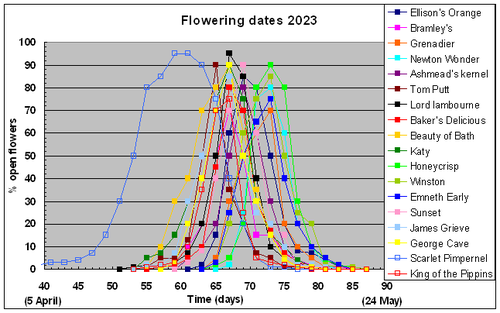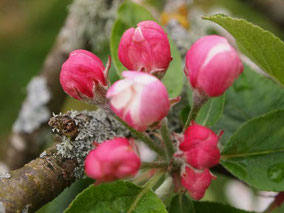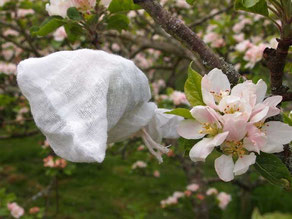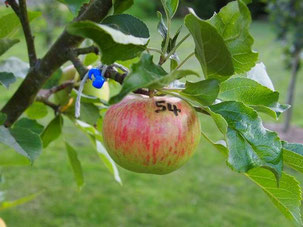Apple Breeding programme
Crossing procedures
Location
All crosses are performed on trees in our ‘no spray’ orchard in Llanilar, near Aberystwyth in West Wales. We grow around forty-five varieties, mostly on MM106 rootstocks, trained as open or central leader bush forms, or as minarettes. The orchard is grassed down with a high proportion of white clover in places. The soil is fairly poor with a few inches of topsoil over stony clay subsoil.
Choice of parental trees
We use self-fertile varieties as the male parent (♂) rather than the female parent (♀) in crosses between self-fertile and self-sterile varieties. This reduces chances of ‘false positive’ results due to self-pollination, arising either from an incomplete emasculation of the ♀flower or its contamination with pollen from an adjacent flower cluster. We also prefer to use older established trees as female parents and younger trees as male parents, when given the choice.
Preparation of flowers for hand pollination

Our crosses are made by hand pollinating flowers on the female parent variety with pollen collected from flowers on the male parent variety. Until 2016 we used fresh pollen rather than stored pollen from pre-dried anthers, because of the possibility (unknown) of epigenetic effects arising from storage. However, since 2016 we have used pollen from flowers collected a few days earlier, air drying these at room temperature to release the pollen from their anthers. This method is more convenient when performing large numbers of crosses, with success rates similar to those achieved with fresh pollen.
A ‘single cross’ is made by pollinating three flowers on the same flowering cluster on the female parent variety with pollen from the male parent variety. Flowers designated for crossing are prepared and protected several days in advance of pollination. Flowering dates vary from year to year, depending on winter and spring weather patterns. Peak flowering dates averaged across 22 varieties grown in our orchard varied by 34 days between 2010 and 2023 (image above). Flowering dates of different varieties also vary widely in a given year, as shown for 2023 in the image below; although the order in which they flower is generally similar from year to year.

Healthy flower clusters on designated female parent varieties are identified at the ‘balloon’ stage of development (i.e. before the petals have opened and the flowers can be pollinated by insects). Three flowers on each cluster are emasculated (image below) to prevent self-pollination, by gently prizing open the petals and removing the pollen-containing, yellow anthers with tweezers, before closing up the petals. All the remaining flowers on the cluster are snipped off. A muslin bag (11cm x 7cm ) is placed over the emasculated cluster, tied with string and tagged with one or more coloured beads. Bagging the cluster prevents unwanted pollination by insects, whilst the beads serve to identify the cross; this is necessary when more than one cross is made on the same tree.



Left: Flowering cluster with flowers at balloon stage: three of the larger, looser flowers are emasculated on each cluster; the remaining flowers are cut off. Note that the flowers on a cluster are all at slightly different stages of development. Centre: Close up of flower with petals removed, showing anthers before their removal, Right: same flower after anthers removed, leaving the female parts of the flower intact.
Flowering clusters on designated male parent varieties are prepared simply by enclosing in muslin bags at the ‘balloon’ stage. All flowers on the cluster are retained. This increases the period during which pollen-ready flowers are available for use from the cluster.
Hand pollination

Emasculated flowers are pollinated by hand as soon as all three flowers on the selected cluster are fully open. This usually occurs a few days after emasculation. We don’t check whether the surface of the stigmas look ‘sticky’ and receptive to pollen.
The pollen for each cross is supplied by either of two methods. In Method 1, two flowers are removed from a ‘bagged’ cluster of flowers on the designated male parent variety. We only use flowers with at least two visibly ripe and dehiscing (pollen releasing) anthers. This is checked for with a hand lens (x10). After removing the petals, the two ‘male’ flowers are gently and repeatedly brushed across the three emasculated flowers (female parent variety) ensuring good contact is made between anthers and stigmas. In Method 2, several flowers are collected from the designated male parent variety at the 'balloon' stage. The petals are removed and these flowers are air dried for several days until pollen is released from the anthers. They can now be used for pollination, by gently brushing them across the emasculated flowers of the female parent, as in Method 1. After hand pollination the muslin bag is replaced over the pollinated cluster of flowers (image above). In reality, the three flowers on the cluster are at slightly different stages of development when they are pollinated. We believe this increases the chance that at least one of them will be successfully pollinated.

Muslin bags are removed from pollinated flowers when stigmas and styles have shrivelled and any fruit has set. This restores natural air circulation and leaf orientation. Tagging bead(s) are tied round the base of the cluster to identify the cross. Later in the season, the cross number is marked on the developing apples with an indelible marker pen (image opposite).